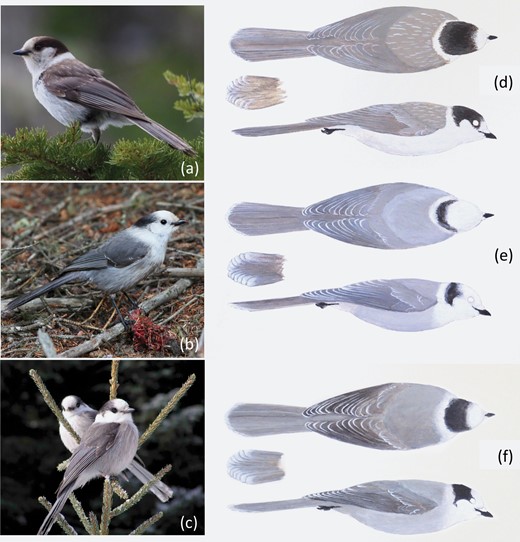Jim LeNomenclatoriste
Je suis un mignon petit Traquet rubicole

Brendan A Graham, Carla Cicero, Dan Strickland, John G Woods, Howard Coneybeare, Kimberly M Dohms, Ildiko Szabo, Theresa M Burg, Cryptic genetic diversity and cytonuclear discordance characterize contact among Canada jay (Perisoreus canadensis) morphotypes in western North America, Biological Journal of the Linnean Society, 2021;, blaa223,

 academic.oup.com
academic.oup.com
Abstract
Three distinct Canada jay (Perisoreus canadensis) morphotypes with easily recognizable plumage traits come into contact in western North America. Recent work demonstrated high genetic structure across the species’ range; however, patterns of genetic variation in these contact zones remain unknown. We categorized 605 individuals into one of three morphotypes (Pacific, Rocky Mountain, and Boreal) based on plumage, and genotyped individuals at the mtDNA control region and 12 microsatellite loci to assess the extent of hybridization between morphotypes. Our data showed cryptic genetic diversity and high cytonuclear discordance among morphotypes within contact zones, which is likely the result of recent and historical admixture. The distributions of the Boreal and Pacific morphotypes each showed a strong association with a single, distinct genetic group, whereas the Rocky Mountain morphotype exhibited higher genetic diversity and was associated with multiple genotypes. Our analyses show the importance of considering both plumage and genetic traits when examining contact zones between closely related taxa. Finally the data presented in this study reaffirm that the Pacific morphotype is distinct from the Boreal and Rocky Mountain morphotypes based on genetic, phenotypic and ecological data, indicating that the Pacific morphotype should be re-elevated to a full species.
Who has access to this revue ?

Cryptic genetic diversity and cytonuclear discordance characterize contact among Canada jay (Perisoreus canadensis) morphotypes in western North America
Abstract. Three distinct Canada jay (Perisoreus canadensis) morphotypes with easily recognizable plumage traits come into contact in western North America. Rece
Abstract
Three distinct Canada jay (Perisoreus canadensis) morphotypes with easily recognizable plumage traits come into contact in western North America. Recent work demonstrated high genetic structure across the species’ range; however, patterns of genetic variation in these contact zones remain unknown. We categorized 605 individuals into one of three morphotypes (Pacific, Rocky Mountain, and Boreal) based on plumage, and genotyped individuals at the mtDNA control region and 12 microsatellite loci to assess the extent of hybridization between morphotypes. Our data showed cryptic genetic diversity and high cytonuclear discordance among morphotypes within contact zones, which is likely the result of recent and historical admixture. The distributions of the Boreal and Pacific morphotypes each showed a strong association with a single, distinct genetic group, whereas the Rocky Mountain morphotype exhibited higher genetic diversity and was associated with multiple genotypes. Our analyses show the importance of considering both plumage and genetic traits when examining contact zones between closely related taxa. Finally the data presented in this study reaffirm that the Pacific morphotype is distinct from the Boreal and Rocky Mountain morphotypes based on genetic, phenotypic and ecological data, indicating that the Pacific morphotype should be re-elevated to a full species.
Who has access to this revue ?








